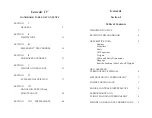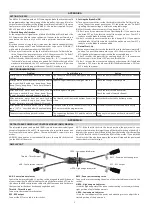
LITESPEED OWNERS MANUAL
Version 1.01
16
PRE-FLIGHT CHECK
As w ith most high performance hang gliders, much of the hardw are and structure is well
enclosed to giv e a streamlined finish to the w ing. This means that y ou must look inside
the sail to check many of the important structural components. You should develop a
consistent routine that incorporates all the necessary checks. If y ou are distracted during
the routine, y ou should start again to ensure nothing has been missed.
1.
As y ou should have already attached y our harness to the glider, check that it is set
up correctly . Ensure that y our parachute is well maintained and stowed appropriately
and that the bridle runs cleanly to the carabineer w hich is attached v ertically to the
hang loops. If y our harness height from base bar needs adjustment, it is best to
acquire the correct length loop from y our Moy es dealer.
2.
Mov e up to the suspension system and verify that the dingle-dangle is rotated
perpendicular to the keel and is free from the nose batten pocket. Check hang loop
and backup.
3.
Open the under surface zip and inspect the cross-bar retainer w ire. Pull the VG on
and off a few times to check that the crossbars are moving freely and the VG system
is operating smoothly and is tied firmly to the clip. Inspect the interior of each w ing,
looking at the back side of the leading edges, the crossbar, and the crossbar
junctions. Check that the cross bar centring w ire is free. This wire is partly loose in
VG full off and should become tight w hen VG is 3/4 on.
4.
5.
Check the apex of the control frame ensuring all nuts are secure and thread is
show ing beyond the nut on the bolt end.
6.
Sight along keel and mov e to the nose section, checking all nuts and bolts.
Test nose catch and ensure keel batten is located correctly . Re-attach nose fairing.
7.
Sight along each leading edge to confirm a similar amount of leading edge
deflection (curv e). Unev en curves will indicate a bent or damaged leading edge.
While sighting dow n the leading edges check each wing for div e stick symmetry , ie.
equal tw ist for left and right w ing.
Check that all internal Velcro’s are attached and are of equal length. If one
side is disconnected or too loose, it may cause a significant turn.
IMPORTANT
!
It is easiest to inspect for tube damage w hen w ings are slightly opened w ith
no battens in the sail. The entire length of the leading edge tubes can be
easily seen at this stage of the set up procedure through the under surface
zippers and centre zip. It is recommended to check for dents or bends at this
stage of set up before each flight.
NOTE
!
Summary of Contents for LITESPEED
Page 1: ...Moyes Delta Gliders Pty Ltd Version 1 01 LITESPEED owners manual...
Page 2: ......
Page 42: ...LITESPEED OWNERS MANUAL Version 1 01 40...
Page 43: ...LITESPEED OWNERS MANUAL Version 1 01 41...
Page 44: ...LITESPEED OWNERS MANUAL Version 1 01 42...
















































